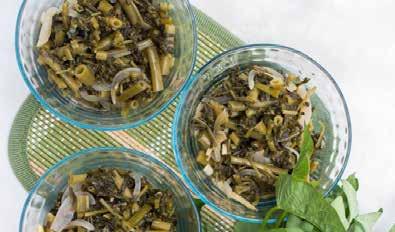
3 minute read
VEGGIE DELICACIES
from Magazine 2021 3Q
by LearnPH

COMPILED BY: SARAH JOY N. RUIZ
Advertisement
In a Food Systems Summit public forum conducted to tackle action track on “ensuring access to safe and nutritious food for all” in November 2020, plant-based diet was placed forth as a theme. The forum was participated in by representatives from 10 countries including USA, UK, Italy, and India. Based on data, food is responsible for 30% of greenhouse gas emissions, whereby livestock or meat is responsible for the 25%. As such, reducing carbon footprints through locally sourced vegetables will not only make us healthy, but also result in a sound, robust environment.
In these recipes, the humble, ordinary vegetables are made more exciting and delectable!
MUSTASANG KIMCHI
Preparation Time: 4-5 days; Makes 1 Jar
Ingredients: 1 bundle fresh mustasa 2L water 6tbsp sea salt 1tbsp grated garlic 1tsp grated peeled fresh ginger
1tsp
granulated sugar 2tbsp fish sauce or soy sauce 3½tbsp red hot pepper, powdered
4 pc medium scallions, trimmed and cut into 1-in pieces Procedure: Mix Brine and Mustasa 1. Dissolve 6tbsp sea salt into 2L of water. 2. Sort and remove wilted mustasa leaves. Add leaves to brine and submerge using a plate or weight, and let them sit for 2h. 3. Rinse the mustasa under cold water 3 times. Set aside to drain in a colander for 15-20min. 4. Cut the mustasa into 1-2in and cut larger leaves lengthwise. 5. Add the garlic, ginger, red pepper, fish or soy sauce, 44ml water, and scallions. Stir into a smooth paste. Set aside until mustasa is ready. 6. Combine paste and mustasa. 7. Gently squeeze any remaining water from mustasa and add it to the spice paste and scallions. 8. Wear gloves and using your hands, gently mix the paste into the mustasa until it is thoroughly coated. 9. Pack and ferment the kimchi in a jar. Push down the kimchi until the brine rises to cover the mustasa leaving at least 1-in of space at the top. Seal the jar. 10. The mustasa will start fermenting a day or two at room temperature, depending on the temperature and humidity of the room. The warmer and more humid it is, the faster the kimchi will ferment. It will then smell and taste sour. Press the top of the kimchi with a spoon to release bubbles from beneath. 11. Check the kimchi once a day by pushing down the mustasa with a clean spoon to keep it submerged and soaked in the brine. 12. When the kimchi tastes good enough for your liking, transfer the jar to the refrigerator. You may start eating it right away, but it’s best after another week or two.
PICKLED KANGKONG
Preparation Time: 45min/ Makes 1 Jar
Ingredients: 4c kangkong stems and leaves, cut into 1-in pieces 1 pc large garlic, peeled and sliced 2 pc red bell peppers, sliced thinly 1 pc small onion, sliced 1 pc ginger, peeled and cut into strips
Pickling Solution: 1½c cane vinegar 1½c sugar 1tsp salt
Procedure: 1. Cut the stems and leaves into 2-3cm. Wash thoroughly and drain. 2. In a pot, blanch the kangkong stems for 3-4min. Drain the excess water and soak the stems with ice water in a bowl for 3min. 3. Mix the vinegar, sugar, and salt and stir constantly to dissolve. Transfer in a sauce pan and simmer the mixture. Once it starts boiling, add the onion, garlic, red bell pepper, and ginger. Simmer the pickling solution for 2min. Allow to cool. 4. Mix the kangkong and the pickling solution in a bowl and transfer in a medium jar. Let it cool down before sealing the lids. 5. Refrigerate for three days to allow improvement of flavor before serving.










